FARM OF THE FIVE CONTINENTS
Meet domestic animals from around the world!
Animals at the Farm

Donkey
Distribution: Africa
Size: 1.4 meters Weight: 180-400 kg
Speed: 50 KM/H Gestation: 12 months
Lifespan: 40 years
A sturdy equine often used as a pack animal. Known for its calm temperament and distinctive braying sound.

Red Kangaroo
Distribution: Australia
Size: 2 meters Weight: 90 kg
Speed: 70 KM/H Gestation: 33 days
Lifespan: 20 years
The largest marsupial in Australia, famous for its powerful tail and impressive leaps. It lives in arid and semi-arid plains.

Patagonian mara
Distribution: South America
Size: 75 cm Weight: 8-16 kg
Speed: 50 KM/H Gestation: 90 days
Lifespan: 14 years
A rodent native to South America that looks like a large rabbit with long legs, living in pairs and very social.

Nandu
Distribution: South America
Size: 1.5 meters Weight: 40 kg
Speed: 60 KM/H Incubation: 40 days
Lifespan: 20 years
A large flightless bird from South America with gray feathers and a long neck. It resembles an ostrich but is smaller.

Emu
Distribution: Australia
Size: 1.5 meters Weight: 200-300 kg
Speed: 70 KM/H Gestation: 11-12 months
Lifespan: 25 years
The second-largest bird in the world, native to Australia, with soft brown feathers. It cannot fly but is very fast on land.

Canada goose
Distribution: North America
Size: 1,2 meters Weight: 3-6 kg
Speed: 80 KM/H Incubation: 28-32 days
Lifespan: 30 years
A large migratory bird with gray plumage and distinctive black and white head markings, known for its melodic call and courtship dances.

Mute swan
Distribution: Asia
Size: 1.5 meters Weight: 10-15 kg
Speed: 80 KM/H Incubation: 35-41 days
Lifespan: 30 years
A large white waterbird with a long elegant neck. Despite its name, it makes some sounds but remains relatively quiet

Peacock
Distribution: Asia
Size: 2.3 meters Weight: 4-6 kg
Speed: 16 KM/H Incubation: 28 days
Lifespan: 20 years
A bird known for its spectacular iridescent blue and green feathers, especially the male who fans out a large colorful tail to attract mates.

Sulcata tortoise
Distribution: Africa
Size: 0.83 meters Weight: 100 kg
Speed: 1 KM/H Incubation: 90-120 days
Lifespan: 70 years
The largest land tortoise in Africa, with a thick shell and known for digging burrows to escape the heat.
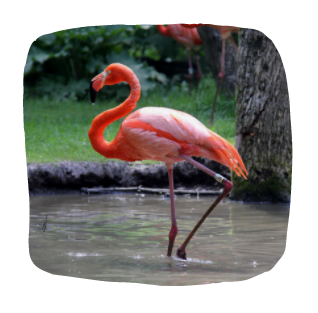
Flamingo
Distribution: Africa, Asia, Europe, Central and South America
Size: 1.2-1.4 meters Weight: 2.2-2.8 kg
Vitesse: n/a Incubation period: 28-30 days
Lifespan: 40 years
Flamingos spend most of their time eating. The crustaceans in their diet, especially shrimps, are rich in carotenoid pigments. It’s what colors the flamingos’ feathers pink. They have small comblike structures inside their bills to filter water and capture prey. They sleep upright on one or two legs with their head in their feathers.
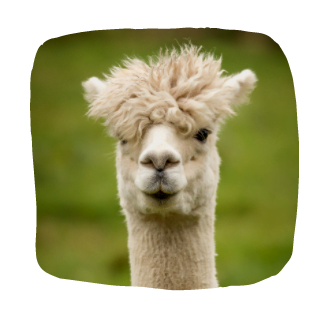
Alpaca
Distribution: South America
Size: 0.75-1 meter Weight: 55-90 kg
Speed: 55 km/h Gestation: 11-12 months
Lifespan: 25-30 years
The alpaca is the llama’s cousin. They live in the Andes at an altitude of 4,500 meters. Alpaca wool is a high quality fiber. It is softer, warmer, more resistant and lighter than sheep’s wool.

Chinese painted quail
Distribution: Asia
Size: 0.15 meter Weight: 0.03-0.04 kg
Speed: 40 km/h Incubation: 16-18 days
Lifespan: 6 years
A small bird with varied plumage, often kept in captivity, recognized for its soft calls and discreet appearance.
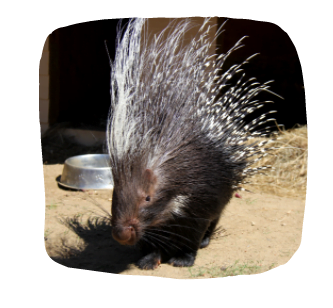
African Porcupine
Distribution: Africa
Size: 65-85 cm Weight: 15-30 kg
Speed: n/a Gestation: 3.5 months
Lifespan: 12-15 years
The African porcupine is the same size as a beaver, they are the largest rodent in Africa. Their quills can measure up to 30 cm long.
The quills are kept tucked back most of the time. Porcupines will bristle them when they are worried or threatened. They cannot throw them, but in case of contact the quills will remain stuck in the victim.
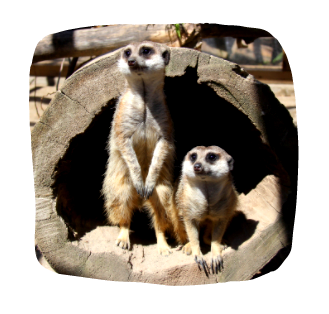
Meerkat
Distribution: South Africa
Size: 25-35 cm Weight: 0.8-1.9 kg
Speed: n/a Gestation: 1.5 months
Lifespan: 12 years
Meerkats have great eyesight, extremely keen hearing and a strong sense of smell. Their claws are very long and are useful to dig burrows.
They live in groups from two to 40+ individuals, called a mob. All the adults take turns as sentries so the others can search for food without worry. The sentry sits on a high spot, stands on two legs, and announces the start of guard duty with a specific call. A low, constant peeping is a sign that all is well. If a predator is spotted, the sentry alerts the others with a bark or hiss. The alert is different for land predators and those coming from the air.
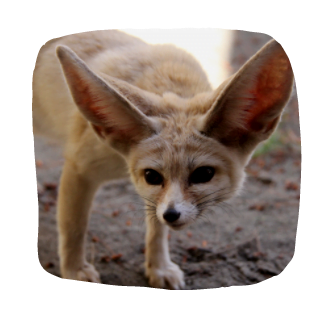
Fennec fox
Distribution: Africa
Size: 20-30 cm Weight: 0.8-1.9 kg
Speed: n/a Gestation: 1.5 months
Lifespan: 12 years
The fennec is nicknamed the desert fox or the sand fox of the Sahara. In their natural environment, the desert, they use their large ears to evacuate heat from their body.
They are omnivorous and eat insects, rodents, snails, lizards, plants, fruits, roots and eggs. They have adapted to live with very little water; most of the water they need comes from the plants they consume.
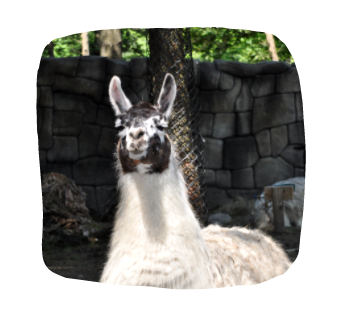
Llama
Distribution: South America
Size: 1-1.2 month Weight: 120-200 kg
Speed: 50 km/h Gestation: 11-12 months
Lifespan: 10-20 years
The llama is domesticated mainly for its lighter, silkier and seven times warmer wool than sheep’s wool. They can also carry up to 20 kilos on their back and their agility in mountainous terrain gives them an advantage over donkeys and horses
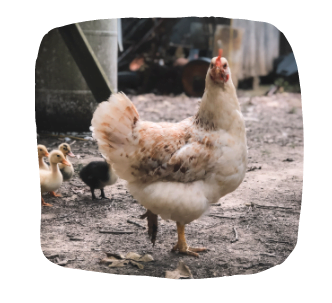
Chicken
Distribution: Worldwide
Size: 0.2-0.4 month Weight: 3-4 kg
Speed: 15 km/h Incubation period: 21 days
Lifespan: 10-12 years
Laying hen begin to lay eggs at 20 weeks and will lay an average of 5 to 6 eggs per week. Fertilized eggs will be incubated for three weeks.
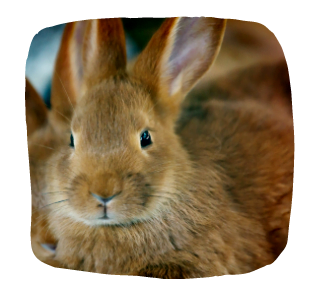
Rabbit
Distribution: Worldwide
Size: 0.4-0.5 meter Weight: 0.4-2.5 kg
Speed: 40 km/h Gestation: 1 month
Lifespan: 8-10 years
There are about thirty species of wild rabbits in the world. Several of them are threatened because they are highly prized by many predators. They have very fine hearing and their powerful back legs make them fast runners.
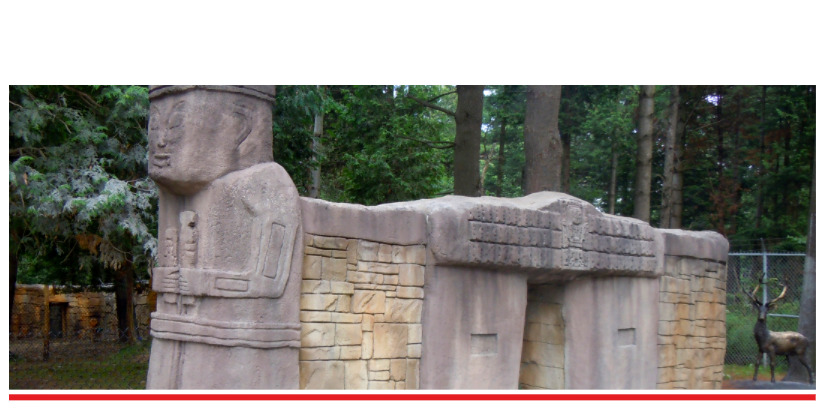
At the Farm you will also see the Inca wall. This long and impressive stone wall is a replica of the spectacular constructions of Sacsayhuamán, Machu Picchu and Cuzco. Several Inca symbols are incorporated into it, such as the nazca lines, the twelve-angled stone of Cuzco, the stone faces of the Kalasasaya temple, the statue and the Sun Gate of Tiahuanaco in Bolivia. There is even a nod to the Mysterious Cities of Gold.